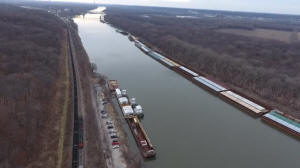|
Since 2022, Corn Belt Ports have attracted over $2 billion in
multi-modal and natural infrastructure investment from the
Infrastructure Investment and Jobs Act and other funding
sources. Officials said the recognition of the Corn Belt Ports
has enabled downstate Illinois to be more competitive for direct
and indirect investment.
“We’ve never made anything like this before but two of our ports
made the Global Trade magazine’s top 50 power ports list, so
we’re really happy about that,” Corn Belt Ports Executive
Coordinating Director Robert Sinkler said during a University of
Illinois Extension webinar.
With more than 100 million tons of freight shipped through the
region each year, Sinkler is optimistic that global markets can
be tapped into.
The Corn Belt Ports are distinct regional units of government
that are county-based, rural multi-modal transportation features
with boundaries compatible with existing regional planning
agencies. Some of the cities recognized as ports include Peoria,
Quincy, Ottawa and Rock Island.
Earlier this year, 10 states, including Illinois, signed a
cooperative endeavor agreement that some believe will lead to
further economic growth. The agreement unifies both the inland
ports of the Mississippi River as well as its coastal ports in
the South.
The Corn Belt Ports system also expanded in September with the
announcement of a collaboration with Iowa. Iowa farmers along
the Mississippi River will have better long-term access to
export markets with the formation of the Ports of Eastern Iowa
Authority.
Recently, mayors from 10 states along the Mississippi River
convened in Baton Rouge, Louisiana, to announce a cooperative
agreement between the working river’s ports. During the
Mississippi River Cities and Towns Initiative meeting, the
mayors also called upon the next U.S. president to prioritize
several policy changes to support the 105 cities included in the
initiative. |
|




